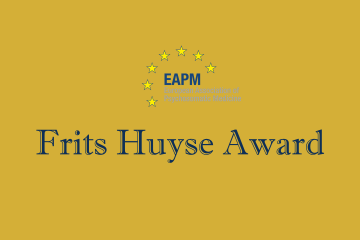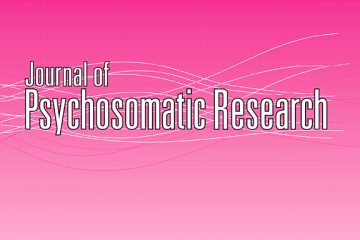The Editor’s choice March 2023
written by Jess G. Fiedorowicz, Editor-in-Chief, Journal of Psychosomatic Research, Professor and Senior Research Chair in Adult Psychiatry, University of Ottawa, Head and Chief of Mental Health, The Ottawa Hospital Scientist, Ottawa Hospital Research Institute, and Antonina Mikocka-Walus, Deputy Editor, Journal of Psychosomatic Research in March 2023.

Jess Fiedorowicz, JPR’s Editor-in-Chief
The Editor’s Choice –
“More Choice Isn’t Better For Nocebo Effects”
This quarter’s Editor’s Choice for the Journal of Psychosomatic Research really piqued our interest and provides some potentially useful clinical pearls. The journal has a strong history of publishing placebo and nocebo research, including a highly cited 2005 article on the role of optimism/pessimism in the placebo response by the senior author of our selection, Andy Geers (1). Our current Editor’s choice makes another strong contribution to this literature. First author Kate Faasse of University of New South Wales (UNSW, Australia) and her colleagues from both New South Wales and the U.S. reported on two studies in the selected paper. These studies were designed as sham treatment (where participants were deceptively told they were receiving active treatment when they actually were receiving placebo) to investigate the nocebo effect. Across both studies, it appeared that being offered a choice of two treatments resulted in a lower level of nocebo effects relative to either no choice or 10 choices (2). The results of this study are of interest to clinicians who may mitigate the risk of nocebo effects by presenting focused, but not overwhelming choices in clinical situations where indicated. The authors provided the following concise summary of their study:
Evidence suggests that when patients or research participants have no choice over the treatment they receive, they experience worse outcomes. We wondered whether the nocebo effect – where aspects of the treatment context can trigger negative outcomes, including side effects, independent of any active components of the treatment – might contribute to worsened outcomes. We tested this possibility using a sham treatment paradigm, and found that while having a choice of two placebos reduced the nocebo effect, having either no choice or a choice of ten placebos resulted in significant nocebo effects. Having some choice – but not too much – improved treatment outcomes.
To better understand the work, we will break down each study from the paper. Study 1 purported to examine the influence of beta-blockers on anxiety. The n=71 volunteers were randomly assigned to no-treatment, no-choice, and a choice between two treatments. Study 2 purported to examine the influence of benzodiazepines on anxiety. It enrolled 120 participants and added an additional group with a choice between 10 treatments. All treatments were inactive (placebos). Compared to no treatment control condition, there was a small and non-statistically significant increase in the symptoms participants had been warned about in those offered two choices, compared to large and statistically significant increases in warned symptoms for those randomly assigned to no or 10 choices as illustrated in Figure 1. There were no significant differences in unwarned symptoms between groups in both studies.
The paper is also a lovely product of a long-standing international collaboration. First author Kate Faasse and senior author Andy Geers first met during a visit by Andy to University of Sydney, where Kate had had just moved to from New Zealand to start her position at UNSW. Both had been doing work on nocebo/placebo effects and then launched into collaborative projects. They have published an impressive collection of papers on this topic (3-8) and have a current grant to study why generic medications appear to generate higher reports of side-effects (presumed nocebo) than branded medications. The Editor’s Choice also featured the work of their students. Study 1 was led by master’s student Annalise de Groot and Study 2 led by honours student Yvette Keevers, now pursuing training in clinical psychology, with substantial contributions from Kate Nicholls, now pursing her PhD in the lab of Dr. Fraasse.
The astute reader of the journal may note that both studies utilized a pool of undergraduate psychology students. Participating students received partial course credit as compensation. The journal scope does mention that “papers will normally be concerned with illness or patients rather than studies of healthy populations.” This sample of undergraduate students that exclude those with anxiety disorder (both studies) or asthma (Study 2) does not fit this bill. Our preceding Editors wrote an editorial expressing concern about the use of undergraduates in research studies (9). Concerns related to the representativeness of such samples, the lack of guarantee about educational gain (as often purported in justification), and the potential for coercion. We share all of these concerns and, in fact, often desk reject studies that utilize undergraduate samples for convenience. In the case of this study, we appreciated the clear disclosure in the manuscript, the broad applicability of nocebo response, including to this select population (10), ethical challenges to studying nocebo response in clinical samples, and the potential clinical utility of the findings. We encourage future research testing similar questions in general population samples or in clinical samples where ethical concerns would not prohibit the induction of nocebo effects. In line with our predecessors, we caution investigators for reflexively utilizing undergraduate or other student samples in their research.
The issue of choice in medical care is of great importance and of great interest. In a representative US study, the vast majority (96%) want to be offered choices and asked their opinions. Interestingly, a slight majority (52%) still prefer the physician make the final decision (11). Thus, it may be important to have a sense of patient opinion and preferences in tailoring treatment to the patients need. Based on the Faasse et al, a couple of choices may be better than no or excessive choices to minimize nocebo effects. Future studies could help understand whether this is influenced by individual preferences for decision making, specific contexts, and varied clinical conditions. Pragmatically, most clinicians likely already narrow the discussion to the 2-3 choices they consider most reasonable for discussion. Based on this study, this may not only improve efficiency and avoid overwhelming the patient. It might also produce better outcomes by minimizing the nocebo effect!
We look forward to seeing future submissions studying placebo or nocebo effects to the Journal of Psychosomatic Research. This research is important and potentially clinically relevant. The journal is proud to have a rich history of disseminating such work as part of our heritage.
REFERENCES
- Geers AL, Helfer SG, Kosbab K, Weiland PE, Landry SJ. Reconsidering the role of personality in placebo effects: dispositional optimism, situational expectations, and the placebo response. J Psychosom Res. 2005 Feb;58(2):121-7. PubMed PMID: 15820839. eng.
- Faasse K, Keevers Y, de Groot A, Nicholls K, Helfer SG, Geers AL. Choice and the nocebo effect: If a little is good, more is better? J Psychosom Res. 2023 Jan;164:111083. PubMed PMID: 36435093. Epub 20221116. eng.
- Barnes K, Faasse K, Geers AL, Helfer SG, Sharpe L, Colloca L, et al. Can Positive Framing Reduce Nocebo Side Effects? Current Evidence and Recommendation for Future Research. Front Pharmacol. 2019;10:167. PubMed PMID: 30894815. PMCID: PMC6414427. Epub 20190306. eng.
- Geers AL, Clemens KS, Faasse K, Colagiuri B, Webster R, Vase L, et al. Psychosocial Factors Predict COVID-19 Vaccine Side Effects. Psychother Psychosom. 2022;91(2):136-8. PubMed PMID: 34736267. PMCID: PMC8678245. Epub 20211104. eng.
- Faasse K, Huynh A, Pearson S, Geers AL, Helfer SG, Colagiuri B. The Influence of Side Effect Information Framing on Nocebo Effects. Ann Behav Med. 2019 Jun 04;53(7):621-9. PubMed PMID: 30204841. eng.
- Geers AL, Clemens KS, Colagiuri B, Jason E, Colloca L, Webster R, et al. Do Side Effects to the Primary COVID-19 Vaccine Reduce Intentions for a COVID-19 Vaccine Booster? Ann Behav Med. 2022 Aug 02;56(8):761-8. PubMed PMID: 35640203. PMCID: PMC9275396. eng.
- Clemens KS, Faasse K, Tan W, Colagiuri B, Colloca L, Webster R, et al. Social communication pathways to COVID-19 vaccine side-effect expectations and experience. J Psychosom Res. 2023 Jan;164:111081. PubMed PMID: 36399990. PMCID: PMC9646444. Epub 20221110. eng.
- Faasse K, Helfer SG, Barnes K, Colagiuri B, Geers AL. Experimental Assessment of Nocebo Effects and Nocebo Side Effects: Definitions, Study Design, and Implications for Psychiatry and Beyond. Front Psychiatry. 2019;10:396. PubMed PMID: 31258492. PMCID: PMC6587910. Epub 20190614. eng.
- Leentjens AF, Levenson JL. Ethical issues concerning the recruitment of university students as research subjects. J Psychosom Res. 2013 Oct;75(4):394-8. PubMed PMID: 24119949. Epub 20130412. eng.
- Henrich J, Heine SJ, Norenzayan A. The weirdest people in the world? Behav Brain Sci. 2010 Jun;33(2-3):61-83; discussion -135. PubMed PMID: 20550733. Epub 20100615. eng.
- Levinson W, Kao A, Kuby A, Thisted RA. Not all patients want to participate in decision making. A national study of public preferences. J Gen Intern Med. 2005 Jun;20(6):531-5. PubMed PMID: 15987329. PMCID: PMC1490136. eng.




0 Comments